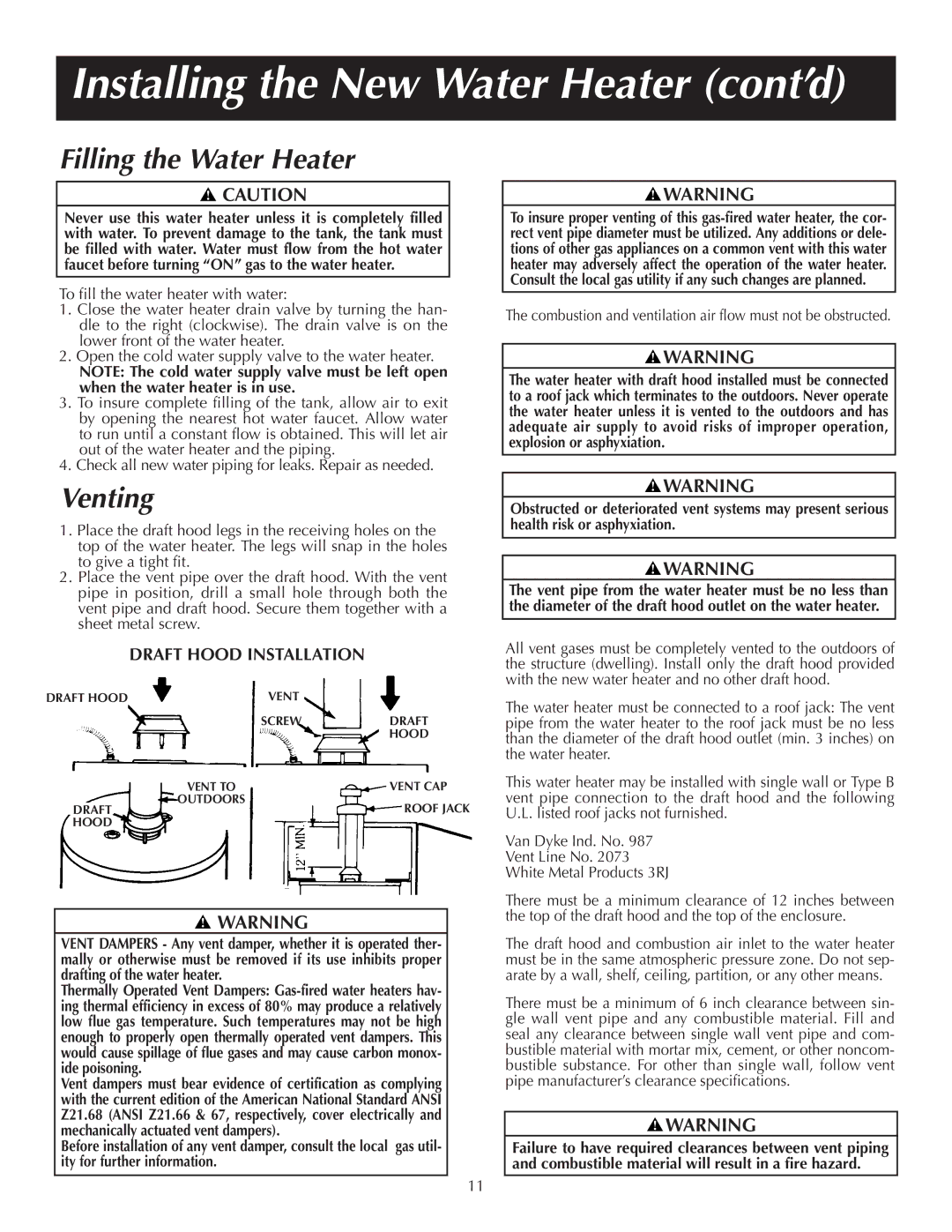
Installing the New Water Heater (cont’d)
Filling the Water Heater
![]() CAUTION
CAUTION
Never use this water heater unless it is completely filled with water. To prevent damage to the tank, the tank must be filled with water. Water must flow from the hot water faucet before turning “ON” gas to the water heater.
To fill the water heater with water:
1.Close the water heater drain valve by turning the han- dle to the right (clockwise). The drain valve is on the lower front of the water heater.
2.Open the cold water supply valve to the water heater.
NOTE: The cold water supply valve must be left open when the water heater is in use.
3.To insure complete filling of the tank, allow air to exit by opening the nearest hot water faucet. Allow water to run until a constant flow is obtained. This will let air out of the water heater and the piping.
4.Check all new water piping for leaks. Repair as needed.
![]() WARNING
WARNING
To insure proper venting of this
The combustion and ventilation air flow must not be obstructed.
![]() WARNING
WARNING
The water heater with draft hood installed must be connected to a roof jack which terminates to the outdoors. Never operate the water heater unless it is vented to the outdoors and has adequate air supply to avoid risks of improper operation, explosion or asphyxiation.
Venting
1.Place the draft hood legs in the receiving holes on the top of the water heater. The legs will snap in the holes to give a tight fit.
2.Place the vent pipe over the draft hood. With the vent pipe in position, drill a small hole through both the vent pipe and draft hood. Secure them together with a sheet metal screw.
DRAFT HOOD INSTALLATION
DRAFT HOOD | VENT |
|
|
| SCREW |
|
|
| DRAFT | ||
|
| HOOD |
|
|
|
|
|
| VENT TO | VENT CAP | |
| OUTDOORS |
| |
DRAFT | ROOF JACK | ||
| |||
HOOD |
|
| |
|
|
![]() WARNING
WARNING
VENT DAMPERS - Any vent damper, whether it is operated ther- mally or otherwise must be removed if its use inhibits proper drafting of the water heater.
Thermally Operated Vent Dampers:
Vent dampers must bear evidence of certification as complying with the current edition of the American National Standard ANSI Z21.68 (ANSI Z21.66 & 67, respectively, cover electrically and mechanically actuated vent dampers).
Before installation of any vent damper, consult the local gas util- ity for further information.
![]() WARNING
WARNING
Obstructed or deteriorated vent systems may present serious health risk or asphyxiation.
![]() WARNING
WARNING
The vent pipe from the water heater must be no less than the diameter of the draft hood outlet on the water heater.
All vent gases must be completely vented to the outdoors of the structure (dwelling). Install only the draft hood provided with the new water heater and no other draft hood.
The water heater must be connected to a roof jack: The vent pipe from the water heater to the roof jack must be no less than the diameter of the draft hood outlet (min. 3 inches) on the water heater.
This water heater may be installed with single wall or Type B vent pipe connection to the draft hood and the following U.L. listed roof jacks not furnished.
Van Dyke Ind. No. 987
Vent Line No. 2073
White Metal Products 3RJ
There must be a minimum clearance of 12 inches between the top of the draft hood and the top of the enclosure.
The draft hood and combustion air inlet to the water heater must be in the same atmospheric pressure zone. Do not sep- arate by a wall, shelf, ceiling, partition, or any other means.
There must be a minimum of 6 inch clearance between sin- gle wall vent pipe and any combustible material. Fill and seal any clearance between single wall vent pipe and com- bustible material with mortar mix, cement, or other noncom- bustible substance. For other than single wall, follow vent pipe manufacturer’s clearance specifications.
![]() WARNING
WARNING
Failure to have required clearances between vent piping and combustible material will result in a fire hazard.
11
